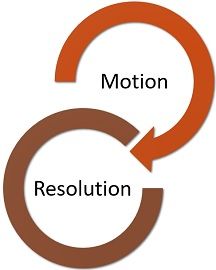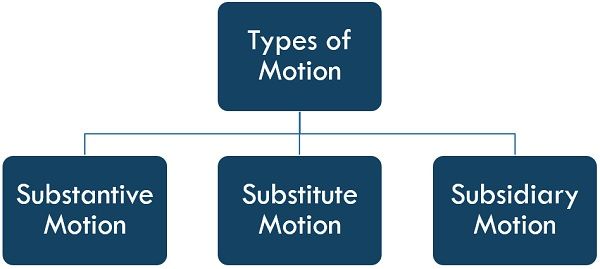 A motion becomes a resolution when the required majority of members accept it. Practically, one member proposes a motion, and another member supports it. The following methods demonstrate the adoption of motion:
A motion becomes a resolution when the required majority of members accept it. Practically, one member proposes a motion, and another member supports it. The following methods demonstrate the adoption of motion:
- Show of hands
- Voting through electronic means
- Demanding a poll or postal ballot.
Ministers and Private Members are eligible to move the motion. If a Minister proposes a motion, then it is given precedence over the motion moved by Private Members.
The motion refers to any proposal brought forward to the House that prompts a decision. Resolution is nothing but the general opinion of the Members of Parliament. This is a formal expression of opinion or a decision agreed upon by all.
With that in mind, we are going to discuss the difference between motion and resolution.
Content: Motion Vs Resolution
Comparison Chart
| Basis for Comparison | Motion | Resolution |
|---|---|---|
| Meaning | The motion refers to a proposal that is placed before the meeting, for the purpose of discussion and decision. | Once the motion is passed it turns out as a resolution, i.e. it shows the general opinion of all members. |
| Binding | No | Yes |
| Recording in minutes | Not recorded in the minutes of the meeting. | It is recorded in the minutes of the meeting. |
| Amendments | Amendments can be made, prior to voting on the motion. | As and when the resolution is passed, it can be amended by passing an amendment resolution. |
| Withdrawal | The motion may be withdrawn by the member who proposes it before the motion is put to vote. | Once the resolution is approved, withdrawal is not possible. |
Definition of Motion
Motion implies a formal suggestion at a meeting. This is meant for deliberation by the members on the matter concerned and ending up with a decision. The matter may be any matter of importance or public interest.
To determine the will of the Parliament, each matter in the House is decided through a question. This question is addressed to the Chairperson on a motion made by a member.
The motion becomes a resolution when the decision is passed. The decision can be positive or negative.
In a Parliament,
- All the proceedings of the Parliament rely on Motions.
- It is the mover of motion who starts the discussion on the motion.
- Unless the motion is withdrawn, the House can opt for either of these three alternatives:
- Approves it completely
- Adopts it with certain amendments as the parliament deems fit
- Rejects it.
- The proposer of the motion presents it in a manner in which he wishes it to be approved by the Parliament and on which votes are easy to obtain.
- Members can also propose amendments if they want the approval of the motion in a different way.
In the case of the company, it is the company’s directors who propose the motion. But when it comes to Parliament, Private Members or Ministers can propose the motion.
In general, one member proposes the motion, and another member second that motion. That is to say, he agrees or supports that motion. And the rest of the people vote in favour of or against the motion.
Also Read: Difference Between Parliamentary and Presidential form of Government
Definition of Resolution
Resolution is the accepted motion or the decision taken in the meeting. The meeting can be a general meeting of companies or the meeting of Members of Parliament. It is binding in nature.
Motion turns out as a resolution in the following way:
- First, a member of parliament proposes a motion and another member supports it.
- Then a fair discussion takes place on that motion.
- Next, the motion is put to vote.
If the votes cast in favour of the motion is more than the votes cast against it. The motion becomes a resolution. To cast the vote the members have to be present in person.
Admissibility of Resolution
To become admissible, the resolution must fulfil the given conditions:
- Clear and precise expression.
- Raise one definite issue substantially.
- Arguments, inferences, ironical expressions, imputations, or defamatory statements should not be there.
- It should not take into account the conduct or character of persons. But it can refer to the person’s official or public capacity.
- It should not deal with any issue which is under settlement or judgment by the court.
Also Read: Difference Between Ordinary Resolution and Special Resolution
Key Differences Between Motion and Resolution
In the following section we will discuss the differences between motion and resolution:
- Motion implies a proposal tabled by a minister or private member before the meeting. The member moves this motion, for the purpose of deliberation.
- Unlike, motion becomes a resolution if members accept it with or without amendments. It indicates the general opinion of all the persons present in the capacity of members.
- Motion is not binding in nature, whereas resolution is binding in nature.
- Motion is not recorded in the minutes of the meeting. Whereas resolution is recorded in the minutes of the meeting.
- In the case of the company, amendments in motion are possible, before voting. Unlike, the company must pass an amendment resolution in the next meeting, to amend the resolution passed in the previous meeting.
- The member who proposes the motion can withdraw it before voting takes place. In contrast, as and when the resolution is approved its withdrawal is not possible.
Types of Motion
There are three types of motion:
- Substantive Motion: An independent proposal is moved and framed in a way that can express the will of Parliament. We can say that all resolutions are substantive motions.
- Substitute Motion: Motion moved as an alternative to the initial motion for considering a policy or any matter.
- Subsidiary Motion: Motion which itself has no meaning. Along with that is not able to express the decision of the House when it does not refer to the original motion. It can be – ancillary motion, superseding motion, and amendments.
Types of Resolution
The three types of resolution are:
- Private Member’s Resolution: Private Members move this resolution in the Parliament.
- Government Resolution: Resolutions moved by the Ministers are government resolutions. Practically, for government resolution, there is no specified notice period. But Ministers give prior notice a few days before the matter is to be proposed. Its aim is to include the resolution in the list of businesses.
- Statutory Resolution: Resolutions are put forward owing to a provision in the Constitution or Act. Private Member or Ministers, give notice regarding this resolution.
Conclusion
Motion facilitates discussion on a matter. However, resolution is the declaration of opinion on that matter. While a motion is brought before the members verbally. The resolution is penned down, for the purpose of recording.






Leave a Reply